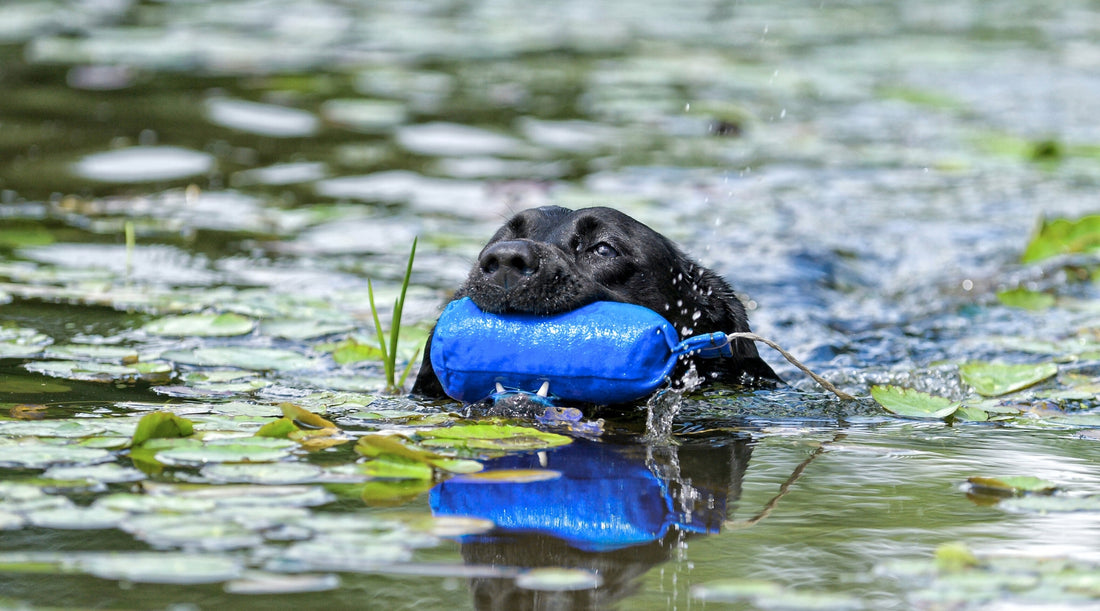
Help! My gundog can’t swim.
Share
It’s essential that our gundogs learn to swim with confidence.
If you have a working gundog, or one you’d like to do working tests with, they need to be able to retrieve from and over water and deliver dummies and game to hand without putting it down to shake.
If you have a pet labrador, spaniel, or HPR, swimming is one of the best forms of exercise for our dogs as it’s low impact and uses a lot of muscles, which can ultimately help protect dogs against injuries.
Swimming is also a great way to keep our dogs cool in the summer months, and, provided they’re introduced to water correctly, it’s good fun for them, too!
When it comes to water, a lot of training and troubleshooting focuses on the key issues which crop up such as over-excitement and unsteadiness, and, the main one, dropping the retrieve to shake.
However, if you’re struggling to get your gundog in the water, it can be difficult to know what the best course of action is.
In this blog, we will look at how we can introduce our gundogs to water in the right way and get them swimming confidently so that you can move on to retrieving from and over water without any pressure.

Aren’t all gundogs natural swimmers?
When it comes to genetics, gundogs do have innate attributes that make them suited for water, like water-repellent double coats and webbed feet. That said, not all gundogs are natural swimmers from the start.
Some dogs want to get in the water and start paddling straight away, while others are more cautious. Every dog is different. Even gundogs known for their love of water can take their time to become confident swimmers.
Under no circumstances should you throw, push or drag your puppy or young gundog into water. If you force them and turn it into a negative and scary experience, you may put them off water for life.
Instead, relax and don’t rush. Focus on making it a fun interaction and go at the pace of your individual dog.
This might mean multiple sessions before they’re swimming, but the extra time spent ensuring a cautious dog is happy to enter the water alone will pay dividends in the long term.

How do I teach my gundog to swim?
The fundamental skill you should focus on initially is confidence in entering the water and teaching your puppy or young gundog to swim on its own accord. We want them to think entering the water is fun and to do so without hesitation.
At this stage, you will want to find a location with easy entry and exit points. The best place would be a calm lake or pond with no steep banks and a nice flat bottom that isn’t too precarious underfoot for you or your dog.
At a minimum, you want to ensure the water has no strong currents, steep banks, or reeds and that no hazardous obstacles are hiding in it that could damage your dog or you.
It is also advisable to wait until the weather and the water temperature are warmer.
If your dog does not immediately rush to explore the water and is reluctant to get more than their paws wet, go with them to the water's edge. If you have found some water with a gently sloping bank, walk into the water as far as your wellies or boots will allow.
You can use food to lure your puppy, paying them for entering the water and then continue rewarding any incremental steps they make.
Remember that dogs are very different. Some will be happy to go deeper into the water, while others might still be reluctant. You must observe your dog carefully and determine how slowly you take this introductory session.
At the end of each session, take note of the point on the dog’s body that they were happy to be submerged in, as this will act as your benchmark for your next session. You aim to build the dog's confidence to submerge slightly deeper in each repetition/session.
Eventually, you will get to a point when their whole body is submerged. At this point, you can start to throw treats out of their reach to encourage them to reach forward and commit to swimming.
Be careful not to throw the food in too far, as if they deem it too far or unreachable, you could halt their progress. Small, progressive steps are better.
You can then work on recalling them from the water and across the water.
You can also begin to put the shake on cue. This will not stop your dog from shaking when it’s not cued, but it will help you to delay it and teach them that you would like them to shake after they have delivered the retrieve to hand.

Why you shouldn’t add retrieves to the water too soon
Throwing a marked retrieve might get your gundog puppy or youngster into the water quickly.
If you have a keen retriever, their desire for the dummy will overcome any fears or worries they have previously had about swimming. But this will not necessarily make them a confident swimmer and can cause a multitude of issues in the long run.
It can lead to dogs that cry and whine on the bank initially before entering the water out of frustration. Some dogs will also try to paw at the water and can sometimes be rewarded if the current is in their favour and the dummy floats towards them.
While this method works, it is also often the root cause of all the water-related training problems we see. Here are some of the reasons why we recommend using food to encourage our gundog puppies and youngsters to take their first swim.
1) Dropping the dummy to shake
Few dogs, especially those new to water, can resist the urge to shake off their wet coats as soon as they get out.
Considering that our puppies and young gundogs are unlikely to have a reliable delivery on land at this stage, it is a big ask to expect them to ignore this natural urge and focus on putting the retrieve article in your hand before shaking.
With this in mind, to avoid dropping the dummy to shake becoming an ingrained habit from day one, we can first avoid introducing the retrieve too soon, and secondly, we can put “shake” on cue.
2) Over excitement around water
If we only teach our dogs to enter the water by encouraging them to retrieve something, they will start to anticipate a retrieve every time they see the water.
For many keen working dogs, this creates a huge amount of excitement and arousal levels go through the roof the second they see water.
This, coupled with the fact that there is usually a lot of distracting wildlife scent around the water’s edge, can quickly tip your dog over threshold.
An over-aroused dog that is not in its thinking mind will be a challenge to work with, and your training session will become more about management than learning.
By removing the retrieving element initially, we can teach our dogs to calmly enter the water just for the simple pursuit of swimming. While some still might find this exciting, it should not rev them up as much as the anticipation of a retrieve.
3) Unsteadiness on marked water retrieves
Like the hand delivery issue, your puppy or young gundog is not yet likely to be steady on land when you introduce them to water for the first time.
If you use the marked retrieve method to encourage them into the water, you will face the contradictory challenge of wanting to manage them (to prevent running in from becoming a habit) while also wanting them to enter the water quickly and confidently.
Unless you fancy combining gundog training with wild swimming, throwing a mark into the water and then going and getting it yourself is also very hard.
If you don’t have multiple dogs, you will inevitably have to send your dog for everything you throw in, which can quickly create a pattern. On seeing the dummy land in the water, the dog automatically assumes they’re about to be sent to retrieve it.
We can prevent this unwanted behaviour chain from forming by teaching them to get into the water and swim on a separate cue.
Later on, this can also help when sending them for blinds and differentiating between a retrieve that is in the water and one that might be just on the bank.
4) Reluctance to cross water
There are plenty of situations where the retrieve will be on the other side of the river, pond or lake.
But puppies and young dogs who have been taught to enter the water by repeatedly being sent in for marked retrieves can often get stuck on the idea that the article will always be in the water.
Instead of crossing and continuing running their line or hunting on land, they often get to the bank and turn around. They can quickly get frustrated swimming in circles, and I have known dogs to try to retrieve water lilies and sticks in an attempt to pick and return with something.
Again, if we separate the act of swimming from retrieving in the early stages, our dogs will not inadvertently learn that water retrieving exclusively involves finding the item in the water.
If you have a puppy or young dog and would like to ensure their first water experience is positive, we have a tutorial in the online membership dedicated to foundation waterwork. For more information head to https://gundogtrainersacademy.co.uk/pages/membership
📸 Photographs 1 credit Alice Loder Photography
